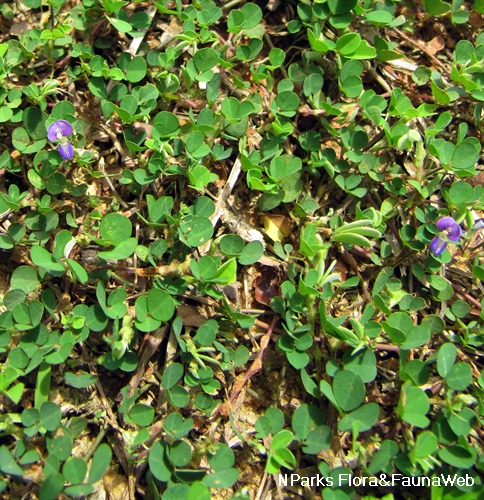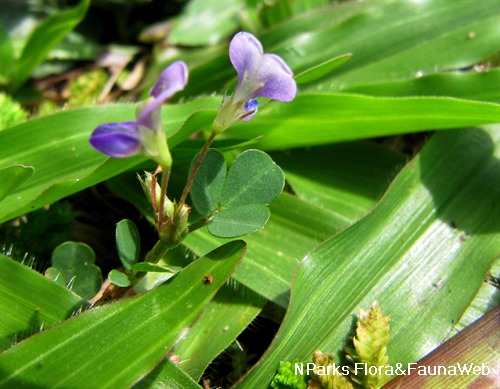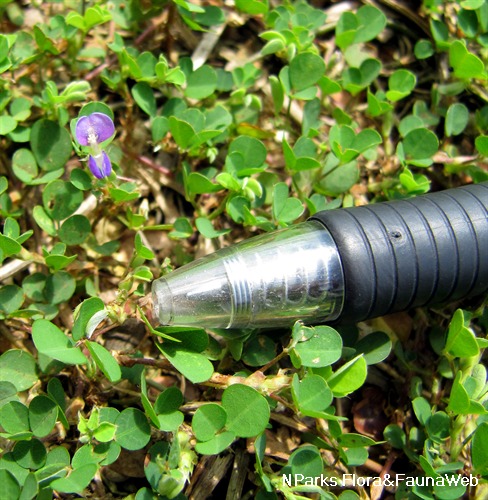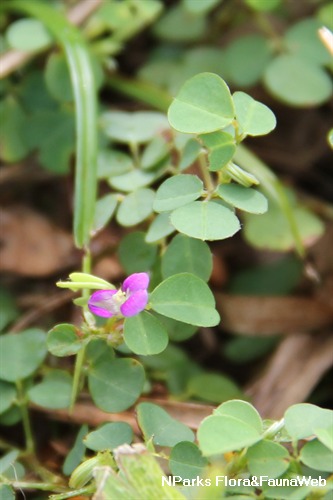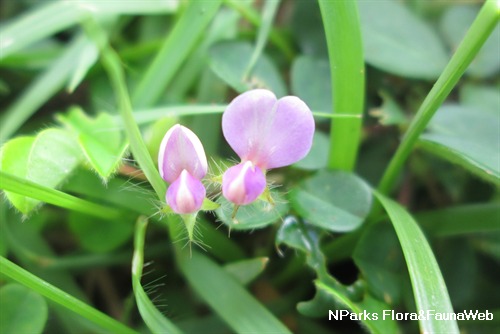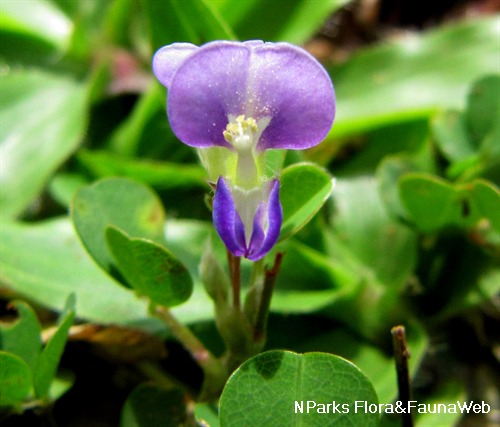
Back
Grona triflora (L.) H.Ohashi & K.Ohashi
| Family Name: | Fabaceae (Leguminosae) |
| Synonyms: | Desmodium triflorum (L.) DC., Desmodium parvifolium Blanco, Hedysarum triflorum L. |
| Common Name: | Creeping Tick Trefoil, Three-flower beggarweed, 三点金 |
Name
Classifications and Characteristics
| Plant Division | Angiosperms (Flowering Seed Plants) |
|---|---|
| Plant Growth Form | Herbaceous Plant |
| Lifespan (in Singapore) | Perennial |
| Mode of Nutrition | Autotrophic |
Biogeography
| Native Distribution | Pantropical |
|---|---|
| Native Habitat | Terrestrial (Grassland / Savannah/ Scrubland, Disturbed Area / Open Ground) |
| Preferred Climate Zone | Tropical |
| Local Conservation Status | Native to Singapore (Least Concern (LC)) |
Description and Ethnobotany
| Growth Form | It is a terrestrial, annual herb that trails along the ground, often up to 50 cm long and rooting at the nodes. |
|---|---|
| Foliage | Its stalked, alternate, compound leaves are trifoliate, about 1 cm long. Each heartshaped leaflet is obovate in shape, leaf tip emarginate, with the centre leaflet not more than 0.6 cm long. |
| Flowers | Its reddish, pinkish to purplish bisexual flowers are borne singly or up to five on axillary inflorescenes. |
| Fruit | Its fruits are slightly curved pods that are hairy, 3-5 jointed, about 1.2-1.3 cm long. |
| Habitat | It grows in turfs, fields, open grasslands and on roadsides. |
| Associated Fauna | Its flowers are probably insect-pollinated. |
| Cultivation | It can be propagated by seed or stem cutting. |
| Etymology | The specific epithet 'triflora is Latin for three-flowered. |
| Ethnobotanical Uses | Medicinal: The plant is used in Chinese medicine to treat dysentry, rheumatism and fever. A decoction of the roots is used by the Malays to treat stomachaches, while a poultice is used for treating skin problems. The plant is also used in Indonesia and the Philippines to treat wounds and ulcers. |
Landscaping Features
| Landscaping | It is suitable as a groundcover as it grows in thick clumps. |
|---|---|
| Desirable Plant Features | Ornamental Flowers, Ornamental Foliage |
| Landscape Uses | General, Parks & Gardens, Small Gardens, Groundcover |
Fauna, Pollination and Dispersal
| Fauna Pollination Dispersal Associated Fauna | Bird-Attracting, Butterfly-Attracting |
|---|---|
| Pollination Method(s) | Biotic (Fauna) |
| Seed or Spore Dispersal | Abiotic |
Plant Care and Propagation
| Light Preference | Full Sun |
|---|---|
| Water Preference | Moderate Water |
| Plant Growth Rate | Fast |
| Rootzone Tolerance | Moist Soils, Well-Drained Soils, Poor Infertile Soils, Shallow Media, Easy to Grow |
| Propagation Method | Seed, Stem Cutting |
Foliar
| Foliage Retention | Evergreen |
|---|---|
| Mature Foliage Colour(s) | Green |
| Mature Foliage Texture(s) | Hairy / Hirsute, Thin |
| Foliar Type | Compound (Trifoliate) |
| Foliar Arrangement Along Stem | Alternate, Spiral |
| Foliar Attachment to Stem | Petiolate |
| Foliar Shape(s) | Non-Palm Foliage |
| Foliar Venation | Pinnate / Net |
| Foliar Margin | Entire |
| Foliar Apex - Tip | Emarginate |
| Foliar Base | Acute |
Floral (Angiosperm)
| Flower & Plant Sexuality | Bisexual Flowers |
| Flower Colour(s) | Pink, Purple, Red |
|---|---|
| Flower Grouping | Cluster / Inflorescence |
| Flower Location | Axillary |
| Flower Symmetry | Bilateral |
Fruit, Seed and Spore
| Mature Fruit Colour(s) | Brown, Green |
|---|---|
| Mature Fruit Texture(s) | Hairy / Hirsute |
| Fruit Classification | Simple Fruit |
| Fruit Type |
Image Repository
Others
| Master ID | 31246 |
|---|---|
| Species ID | 5641 |
| Flora Disclaimer | The information in this website has been compiled from reliable sources, such as reference works on medicinal plants. It is not a substitute for medical advice or treatment and NParks does not purport to provide any medical advice. Readers should always consult his/her physician before using or consuming a plant for medicinal purposes. |

